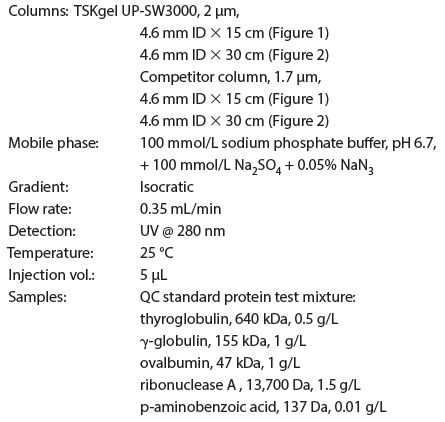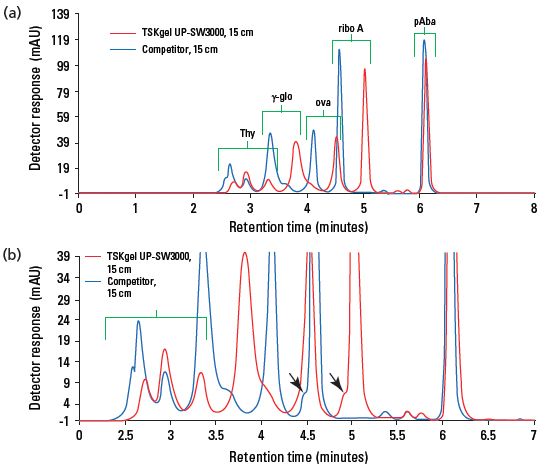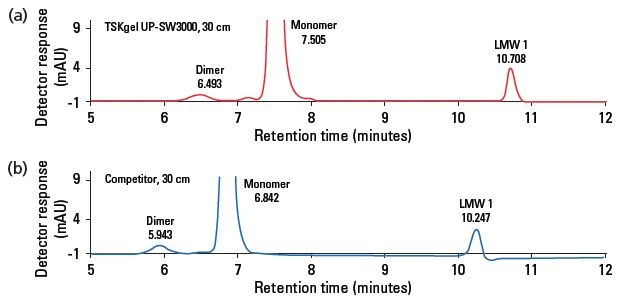Increased Resolution and Reproducibility with TSKgel® UP-SW3000 Columns Versus a Competitive Column
TSKgel UP-SW3000 columns are 2 µm SEC columns designed for the analysis of monoclonal antibodies and other biopharma products. Higher resolution can be achieved for the separation of antibody monomers, dimers, and higher order aggregates with a TSKgel UP-SW3000 column compared to a competitor UHPLC column. The TSKgel UP-SW3000 column provided excellent reproducibility for the peak parameters of retention time, asymmetry, and column efficiency. As demonstrated by the %RSD values, injection-to-injection reproducibility was superior to the competitor column.
TSKgel UP-SW3000 columns are 2 µm SEC columns designed for the analysis of monoclonal antibodies and other biopharma products and can be used on both HPLC and UHPLC systems. The columns are packed with silica-based beads shielded with a hydrophilic diol-type bonded phase that prevents the silica surface from interacting with protein samples.
TSKgel UP-SW3000 columns are available in 4.6 mm ID with 15 or 30 cm length. Higher resolution can be achieved for the separation of antibody monomers, dimers, and higher order aggregates with a TSKgel UP-SW3000 column compared to a competitor UHPLC column. In addition, a TSKgel UP-SW3000 column yielded very low percent relative standard deviation (%RSD) for peak parameters including: retention times, peak asymmetry, and efficiency, demonstrating the exceptional reproducibility of this column versus a competitor UHPLC column.
Experimental Conditions

Click here to view full-size graphic
Results and Discussion
The separation of a QC standard protein mixture on a 15 cm TSKgel UP-SW3000 column compared to a competitor UHPLC column of the same length is depicted in Figures 1a and 1b. Clearly, the TSKgel UP-SW3000 column yielded better separation of thyroglobulin on the high molecular weight (HMW) side of the monoclonal antibody monomer of 150 kDa, as indicated by the brackets in Figure 1b. In addition, the resolution between thyroglobulin and γ-globulin peaks and the γ-globulin and ovalbumin peaks also have higher resolution in the case of the TSKgel UP-SW3000 column although particle size is slightly larger than in the competitor column.

Figure 1a: Comparison of QC standard protein mixture using TSKgel UP-SW3000 and competitor column.
Figure 1b: Comparison of QC standard protein mixture using TSKgel UP-SW3000 and competitor column – zoomed in view.
The number of theoretical plates for the competitor column was 22,618, while 27,082 was obtained for the TSKgel UP-SW3000 column. In the case of γ-globulin (150 kDa), the TSKgel UP-SW3000 column also yielded a larger number of theoretical plates (2,738) compared to 2,675 for the competitor column. The difference in intensity of the proteins comes from two different preparations containing the same amount of pAba.

Figure 2a: mAb analysis using TSKgel UP-SW3000 column.
Figure 2b: mAb analysis using competitor UHPLC column.
A monoclonal antibody was analyzed using a TSKgel UP-SW3000, 30 cm column and a 30 cm competitor UHPLC column, as shown in Figures 2a and 2b. The TSKgel UP-SW3000 column provided excellent reproducibility for the peak parameters of retention time, asymmetry, and column efficiency. Injection-to-injection reproducibility was superior to the competitor column as demonstrated by the %RSD values in Table I.

Table I: Comparative analysis of peak parameters of TSKgel UP-SW3000 and competitor column.
Conclusion
TSKgel UP-SW3000 columns are 2 µm SEC columns designed for the analysis of monoclonal antibodies and other biopharma products. Higher resolution can be achieved for the separation of antibody monomers, dimers, and higher order aggregates with a TSKgel UP-SW3000 column compared to a competitor UHPLC column. The TSKgel UP-SW3000 column provided excellent reproducibility for the peak parameters of retention time, asymmetry, and column efficiency. As demonstrated by the %RSD values, injection-to-injection reproducibility was superior to the competitor column.
Tosoh Bioscience and TSKgel are registered trademarks of Tosoh Corporation.

Tosoh Bioscience LLC
3604 Horizon Drive, Suite 100, King of Prussia, PA 19406
tel. (484) 805-1219, fax (610) 272-3028
Website: www.tosohbioscience.com

SEC-MALS of Antibody Therapeutics—A Robust Method for In-Depth Sample Characterization
June 1st 2022Monoclonal antibodies (mAbs) are effective therapeutics for cancers, auto-immune diseases, viral infections, and other diseases. Recent developments in antibody therapeutics aim to add more specific binding regions (bi- and multi-specificity) to increase their effectiveness and/or to downsize the molecule to the specific binding regions (for example, scFv or Fab fragment) to achieve better penetration of the tissue. As the molecule gets more complex, the possible high and low molecular weight (H/LMW) impurities become more complex, too. In order to accurately analyze the various species, more advanced detection than ultraviolet (UV) is required to characterize a mAb sample.













